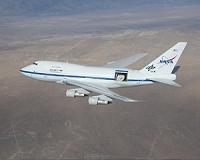 |
Bonn, Germany (SPX) Apr 08, 2011 On 6 April 2011, German scientists carried out their first astronomical observations on board the Stratospheric Observatory for Infrared Astronomy, SOFIA. A joint project between NASA and the German Aerospace Center, SOFIA is the world's only operational airborne observatory. Flying at altitudes above 10 kilometres, SOFIA is able to perform observations not possible with ground-based telescopes, due to atmospheric water vapour absorption. The first observations with the German Receiver for Astronomy at Terahertz Frequencies, GREAT, included spectra of the Omega Nebula (M17), an active star-forming region in the Milky Way, and the galaxy IC 342, located a few million light years away. At 06:40 local time (15:40 CEST) on 6 April, with SOFIA touching down once again at its home base, the Dryden Aircraft Operations Facility in Palmdale, California, Rolf Gusten and his team successfully concluded their first science flight with GREAT. The instrument had been pointed at, among other objects, IC 342, a prominent intermediate spiral galaxy in the constellation Camelopardalis, and M17, an active massive star-forming region 5000 light years away. For both sources, the radiation from ionised carbon at 1.9 terahertz (158 microns) and the high rotational transitions of warm carbon monoxide were measured, providing a tool to probe the interstellar medium in the environments around newly-formed massive stars. Rolf Gusten, the Principal Investigator for GREAT, was delighted by the success: "These very first spectra are the reward for many long years investing in cutting edge technology developments and they showcase the scientific potential of airborne far-infrared spectroscopy. Thanks to the large collecting area of the 2.7-metre diameter telescope, together with enormous progress in terahertz technology, the collection of data is 100 times faster compared to earlier experiments, opening a new pathway for unique scientific experiments." The GREAT instrument was developed by a team from the Max Planck Institute for Radio Astronomy (MPIfR) and the University of Cologne, led by Rolf Gusten, in collaboration with the Max Planck Institute for Solar System Research and the DLR Institute of Planetary Research. "GREAT's first science flight is the beginning of German-American scientific collaboration on SOFIA. We are confidently looking forward to the upcoming routine operations," said Alois Himmes, SOFIA Project Manager at DLR. After these first observing flights with GREAT, the observatory will be open to astronomers outside the project. "Astronomers from all German institutes have been able to apply for scientific observation time with SOFIA during the summer of 2011. They will use either GREAT or the US Faint Object InfraRed-CAmera for the SOFIA Telescope, FORCAST," explained Alfred Krabbe, Head of the German SOFIA Institute (Deutsches SOFIA Institut; DSI) at the University of Stuttgart.
GREAT GREAT is one of two first generation German instruments for SOFIA developed by the Max Planck Institute for Radio Astronomy (MPIfR) and the University of Cologne, in collaboration with the Max Planck Institute for Solar System Research and the DLR Institute of Planetary Research. Rolf Gusten (MPIfR) is the project manager for GREAT. The development of the instrument was financed by the participating institutes, the Max Planck Society, the German Research Foundation (Deutsche Forschungsgemeinschaft; DFG) and DLR.
SOFIA
M17SW The radiation from the cluster ionises and heats the molecular gas, possibly compressing it into a state where more stars form. The SOFIA observations allow researchers to distinguish the effect of this radiative compression from the heating effect that would instead lead to expansion. In this way, the future of the molecular cloud with regard to its star formation activity can be predicted.
IC 342 The young stars heating the surrounding gas and dust are responsible for the rich chemistry and intense emission of these regions, known as Photon Dominated Regions (PDRs). The strong emission from these PDRs allows an in-depth study of the chemical and physical conditions in these distant massive star-forming regions.
Share This Article With Planet Earth
Related Links Max Planck Institute for Radio Astronomy Space Telescope News and Technology at Skynightly.com
 GREAT Spectrometer Readied For Flight On SOFIA
GREAT Spectrometer Readied For Flight On SOFIAEdwards AFB CA (SPX) Apr 01, 2011 Scientists recently completed a series of nighttime, ground-based testing of the German Receiver for Astronomy at Terahertz Frequencies, or GREAT, spectrometer in preparation for a series of astronomical science flights on the Stratospheric Observatory for Infrared Astronomy in April. With the SOFIA 747SP aircraft positioned on the ramp outside NASA's Dryden Aircraft Operations Facility, t ... read more |
|
| The content herein, unless otherwise known to be public domain, are Copyright 1995-2010 - SpaceDaily. AFP and UPI Wire Stories are copyright Agence France-Presse and United Press International. ESA Portal Reports are copyright European Space Agency. All NASA sourced material is public domain. Additional copyrights may apply in whole or part to other bona fide parties. Advertising does not imply endorsement,agreement or approval of any opinions, statements or information provided by SpaceDaily on any Web page published or hosted by SpaceDaily. Privacy Statement |